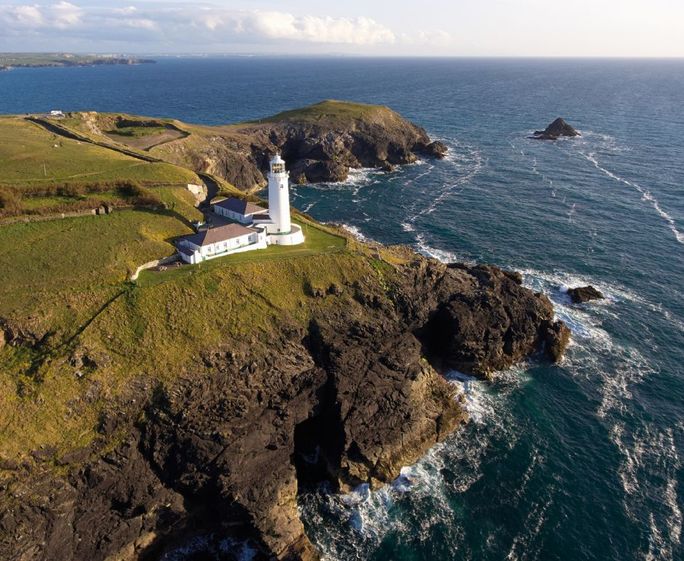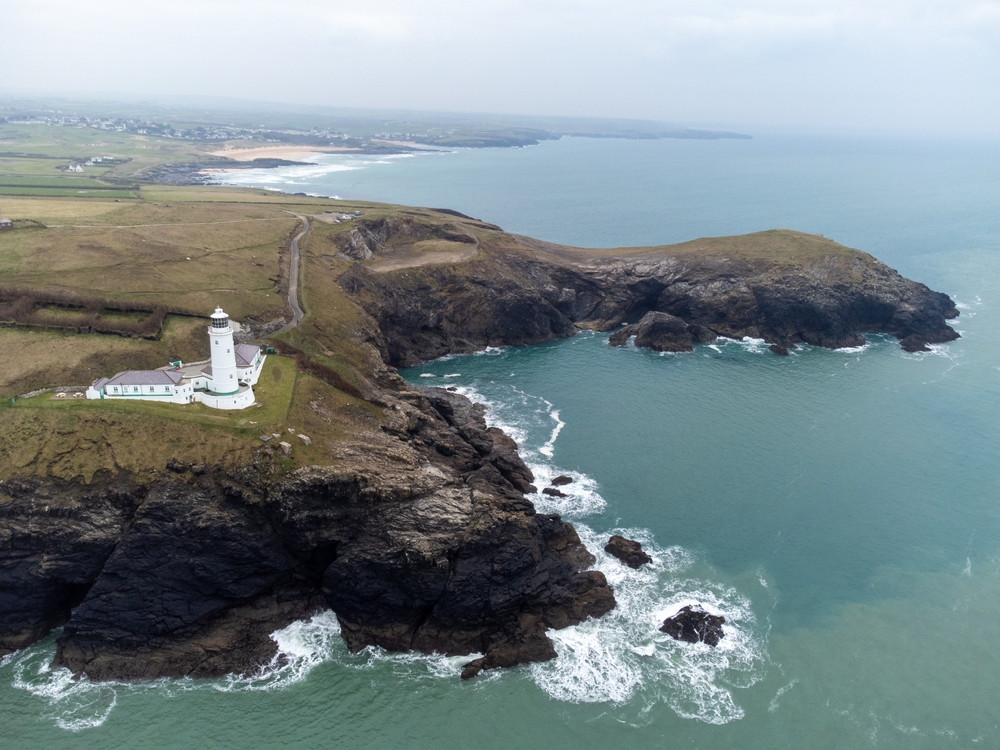Trevose Head, not far from Padstow, is one of the most spectacular headlands in the whole of Cornwall. Standing on the heights of this bulbus finger of rock offers the walker uninterrupted views of over 70 miles of stunning coastline – from Pendeen Watch in Penwith, 35 miles to the west, to Hartland Point in Devon, 40 miles east.
But beyond this panorama and the splendour of the promontory itself there is much to interest and engage the visitor on this particular part of the coast – from the elegant white tower of lighthouse to the abundant wildlife and striking geology, to tales of lost churches and dastardly wreckers.
National Trust
Trevose, which is cared for by the National Trust, stands sentinel in this is a wild and dynamic seascape with Mother Ivery’s Bay on one side, a place of ancient curses and a prehistoric burial site, and Constantine Bay on the other, where a chapel and holy well lie buried in the sand.
Dinas Head
The whole headland is littered with ancient remains, which include Mesolithic flint finds and the more obvious humps of the Bronze Age barrows below the turf. The geology of the cliffs at Dinas Head, a formation jutting out from the main headland, is particularly interesting. Sometimes known as the Marble Cliffs, the rocks there show striking alternate parallel strips of rock in pink and grey.
Another impressive geological feature close to Dinas Head is Round Hole. This circular chasm was formed when the roof of a huge sea cave collapsed leaving a gaping hole that drops some 40m from the cliff top down to sea level. When the waves are rough sea-spray billows up from its depths, while its sheer walls have become a nesting site for a family of ravens. (Take extreme care when near to the unfenced edge and keep children and dogs close.)
Trevose Lighthouse
The Trevose Lighthouse is the most conspicuous feature of the headland, and the history of its construction reads a little like a cautionary tale. Its light was first lit in December 1847, but this was only after many decades of petitioning by the navy, captains, sailors and the local people of the area.
The first official application for a lighthouse was made to Trinity House by the Admiralty in the summer of 1809, this was followed by another in 1813. But nothing was done. And given the accounts of the numerous wrecks in the waters around the headland it is not hard to see why so many felt that there was a desperate need for a lighthouse.
Trevose Head is sometimes referred to as The Lizard Point of the Bristol Channel. The area was often the first landfall for ships crossing the Atlantic and the channel played host to a procession of sea traffic, sailing boats and steam colliers bound to or from South Wales.
Unfortunately however, like the Lizard Point, both Trevose Head and Pentire Point project menacingly out into the sea from the natural line of the coast making them a serious hazard to shipping. The danger is compounded by one of the cruellest reefs in the area churning the water beneath the cliffs. Bull Rock, a small island, lies just of shore and just under a mile westwards the Quies islets hide just beneath the water. Wreck after wreck had come to grief in the area.

Shipwrecks
In the winter of 1808, the Integrity from North Shields lost her masts in a storm and ended up on the sands of Constantine Bay, the next day, 18th November, the sloop Elizabeth from Brighton lost all hands when she came ashore in Treyarnon Bay. In November 1811 the Dundee brigantine Star sank with the loss of all her crew, the same fate met the schooner Ann in 1814 and then the brig Betsy in March 1815.
The cliffs claimed the Swansea brig Concord in January 1820 with the loss of the captain’s wife and children. On other occasions the Pearl, the Lyme Packet, the Duchess of Somerset, the Francis, the Catherine, the Fly and the Agenoria were all wrecked with no survivors.
In 1843 four ships were sunk in just one stormy October night, while a further three came ashore at Widemouth Bay a little further along the coast. Trevose truly was a graveyard for ships.
In 1843, after the terrible death toll of another Cornish winter, the Royal Cornwall Gazette wrote:
“The losses occasioned by every succeeding gale of wind show the necessity of a lighthouse on Trevose Head to point out to mariners their situation and prevent their getting into the Bays, from which they can seldom work out again . . .”
Trinity House finally listened to the constant pleas for help and began work on the lighthouse in 1845, nearly 40 years after the first official request. And, although construction was not as difficult as it would have been for a lighthouse out at sea such as Wolf Rock, it still took two and a half years to complete. Cottages for the keepers were also erected nearby and the entire project cost £7331 4s 6d.
Following the coastal path round from the lighthouse towards Mother Ivey Bay walkers will discover the ‘new’ Padstow Lifeboat Station, built to replace the much older one found closer to the town. Completed in 2006 RNLI Padstow has to be one of the most dramatic and picturesque stations in the UK and it is home to new Tamar class station lifeboat ON1283 Spirit of Padstow, which continues the town’s long tradition of rescue.
Between 1826 and the present day the crew of the Padstow lifeboat have been awarded 30 medals for bravery, 28 Silver and two Bronze, and have saved countless lives all while risking their own. (You can read more about the history of the Padstow lifeboat here.)
The whole of Trevose Head makes a wonderful place to explore for the day, whether you are looking for a coastal walk, a place to do some bird watching or somewhere for a spectacular seaside picnic. There are circular walks, signposted by the National Trust, taking you to lovely sandy beaches for relaxing or perhaps a quick swim.
Parking and a map of the area, with the walking routes marked, can be found close to the lighthouse near the end of the headland.
